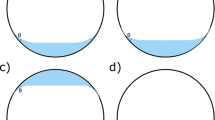Abstract
Silicone oil inside the vitreous cavity exerts forces on to the retina as a result of buoyancy, volume displacement, and surface tension. Surface tension rather than viscosity is the key to understanding why the oil seals retinal breaks effectively. The physics of the tamponade was studied quantitatively. Retinal traction can be counteracted by the oil up to a calculated threshold value, depending on the size and shape of the tear, the strength of the surface tension and, most importantly, the distance between the retina and choroid. For a nearly flat retinal hole, the tamponade is very effective. These theoretical results imply straightforward rules for surgery, rules that have been tested in 150 operations. An attempt must be made to fill 100% of the vitreous cavity. Since the air-water boundary has 3 times the surface tension of the water-oil boundary, the most effective procedure is to flatten the retina by means of a fluid-gas exchange and then clamp it in a flat position, implanting the silicone oil. Silicone in the subretinal space or the anterior chamber tends to retract spontaneously, for surface tension causes the smaller bubble to blow up the larger one. Surgical methods are described to make use of it.
Similar content being viewed by others
References
Ando F (1985) Intraocular hypertony resulting from pupillary block by silicone oil. Am J Ophthalmol 99:87–88
Ando F, Kondo J (1983) A plastic tack for the treatment of retinal detachment with giant tears. Am J Ophthalmol 95:260–261
Charles S (1981) Vitreous micorsurgery. Williams & Wilkins, Baltimore London
Cibis PA, Becker B, Okun E, Canean S (1962) The use of liquid silicone in retinal detachment surgery. Arch Ophthalmol (New York) 68:590–599
Gnad H (1986) An intraocular balloon for silicone oil implantation. Graefe's Arch Clin Exp Ophthalmol 224:32–33
Gnad H, Klemen UM, Radda TM (1983) Healon als innere Tamponade der Netzhautchirurgie. Klin Monatsbl Augenheilkd 183:184–186
Gonvers M (1985) Temporary silicone oil tamponade in the management of retinal detachment with proliferative vitreoretinopathy. Am J Ophthalmol 100:239–245
Haut J, Larricart JP, Van Effenterre G, Pinon-Pignero FL (1985) Some of the most important properties of silicone oil to explain its action. Ophthalmologica 191: 150–153
Joos G (1959) Lehrbuch der theoretischen Physik. Akademische Verlagsgesellschaft, Frankfurt/Main, pp 209–214
Landers MB III, Robinson D, Olsen KR, Rinkoff J (1985) Slit-lamp fluid-gas exchange and other office prodedures following vitreoretinal surgery. Arch Ophthalmol 103:967–972
Machemer R, Parel JM, Norton EWD (1972) Vitrectomy: a pars plana approach. Technical improvements and further results. Trans Am Acad Ophthalmol Otolaryng 76:462–467
Petersen J (1986) Silikon-Öl in der Vorderkammer des aphaken Auges: Vermeiden und Beheben dieser Komplikation. Fortschr Ophthalmol 83:587–589
Pohl RW (1969) Mechanik, Akustik, Wärmelehre. Springer, Berlin Heidelberg New York, pp 114–138
Scott JD (1975) The treatment of massive vitreous retraction by separation of preretinal membranes using liquid silicone. Mod Probl Ophthalmol 15:285–290
Scott JD (1977) A rationale for the use of liquid silicone. Trans Ophthalmol Soc UK 97: 235–237
Scott JD (1981) Use of liquid silicone in vitrectomized eyes. Dev Ophthalmol 2: 185–190
Stenkula S, Ivert L (1984) Sodium hyaluronate (Healon) as an intravitreal aid in retinal and vitreous surgery. J Ocular Ther Surg 12:109–114
Yoshizumi MO, Dunn B, Ligh JK, Altaian RM (1985) Physical properties of vitamin E oil and silicone oil. Retina 5:163–167
Zivojnovic R, Mertens DA, Peperkamp E (1982) Das flüssige Silikon in der Amotiochirurgie. II. Bericht über 280 Fälle — weitere Entwicklung der Technik. Klin Monatsbl Augenheilkd 181:444–452
Author information
Authors and Affiliations
Rights and permissions
About this article
Cite this article
Petersen, J. The physical and surgical aspects of silicone oil in the vitreous cavity. Graefe’s Arch Clin Exp Ophthalmol 225, 452–456 (1987). https://doi.org/10.1007/BF02334175
Received:
Accepted:
Issue Date:
DOI: https://doi.org/10.1007/BF02334175




